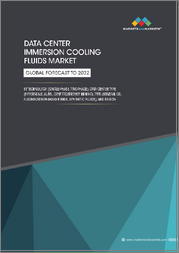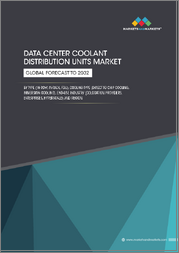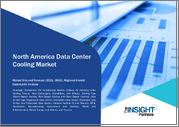
|
시장보고서
상품코드
1769474
유럽의 데이터센터 냉각 시장 : 제품별, 용도별, 국가별 - 분석과 예측(2025-2035년)Europe Data Center Cooling Market: Focus on Product, Application, and Country-Level Analysis - Analysis and Forecast, 2025-2035 |
||||||
유럽의 데이터센터 냉각 시장 규모는 2024년 67억 6,000만 달러에서 2035년에는 205억 5,000만 달러에 달하며, 예측 의기간인 2025-2035년 CAGR은 10.18%에 달할 것으로 예측됩니다.
데이터 세대 증가, 클라우드 컴퓨팅, 디지털 인프라의 확장이 유럽 데이터센터 냉각 산업을 주도하고 있습니다. 고성능 컴퓨팅에 대한 요구가 증가함에 따라 장비의 신뢰성과 가동 시간을 유지하기 위해 효율적인 냉각 시스템이 필수적이며, EU의 엄격한 규정과 지속가능성 목표가 시장에 영향을 미쳐 저에너지 및 친환경 냉각 기술로 전환하고 있습니다. 이 지역에서는 높은 초기 투자 비용과 시스템 복잡성이라는 장애물이 여전히 존재하지만, 지속적인 기술 혁신과 에너지 사용량 절감에 대한 압박이 증가함에 따라 첨단 에너지 효율적인 냉각 솔루션의 채택이 가속화되고 있습니다.
| 주요 시장 통계 | |
|---|---|
| 예측 기간 | 202-2035년 |
| 2025년 평가 | 78억 달러 |
| 2035년 예측 | 205억 5,000만 달러 |
| CAGR | 10.18% |
시장 소개
유럽의 데이터센터 냉각 시장은 인공지능, 클라우드 컴퓨팅, 데이터 생산과 관련된 워크로드의 급격한 증가로 인해 빠르게 변화하고 있습니다. 데이터센터가 대형화, 복잡화됨에 따라 하드웨어 수명, 운영 연속성, 규제 준수를 유지하기 위해서는 효과적인 열 관리가 필수적입니다. 냉각 시스템은 전체 데이터센터 에너지 소비의 최대 40%를 차지할 수 있으므로 에너지 효율이 높은 솔루션은 이 지역 사업자들의 전략적 초점이 되고 있습니다.
EU의 기후 규정, 재생에너지 지침, 유럽 그린딜(European Green Deal)에 따른 지속가능성 추진의 결과, 저탄소, 수랭식, 친환경 냉각 기술이 이 지역에서 확산되고 있습니다. 탄소 및 물 효율이 높고 친환경적인 냉각 기술이 이 지역에 보급되고 있습니다.
유럽의 다양한 기후는 냉방 전술에도 영향을 미칩니다. 남부 지역에서는 더운 날씨에도 효율을 유지할 수 있는 내구성이 뛰어난 솔루션이 필요한 반면, 북부 지역에서는 기계 시스템에 대한 의존도를 줄이기 위해 주변 냉기의 혜택을 누릴 수 있습니다. 유럽의 데이터센터 냉각 시장은 규제 강화와 디지털 인프라의 성장에 따라 지속적으로 혁신과 성장을 이어갈 것으로 예측됩니다.
시장 세분화
세분화 1: 최종사용자 산업별 세분화
- IT·통신
- 헬스케어
- 소매업
- 은행, 금융서비스, 보험, 보험
- 정부-공공기관
- 제조업
- 기타
세분화 2: 데이터센터 유형별 세분화
- 중앙집중형 데이터센터
- 하이퍼스케일
- 코디네이션
- 기업
- 엣지 데이터센터
세분화 3: 용도별
- 인공지능(AI)
- 고성능 컴퓨팅(HPC)
- 클라우드 컴퓨팅
- 엣지 컴퓨팅
- 기타
부문 4: 솔루션별
- 공랭식
- 에어컨
- 에어 핸들링 유닛
- 냉각기
- 냉각탑
- 이코노마이저 시스템
- 기타
- 액체 냉각
- 직접 냉각
- 리어 도어형 열교환기(RDHX)
- 프리쿨링
부문 5: 랙 밀도별
- 낮은 랙 밀도(1-4kW)
- 중형 랙 밀도(5-9kW)
- 높은 랙 밀도(9kW 이상)
세분화 6: 국가별
- 독일
- 프랑스
- 영국
- 이탈리아
- 네덜란드
- 스페인
- 기타
유럽 데이터센터 냉각 시장 시장 동향, 촉진요인 및 과제
- 고밀도 AI 및 HPC 워크로드를 관리하기 위한 수랭식 및 액침냉각으로의 전환
- ESG 및 탄소 중립 목표를 달성하기 위해 에너지 효율적이고 지속가능한 냉각 시스템에 대한 관심이 높아지고 있습니다.
- 북유럽과 같은 추운 지역에서는 에너지 소비를 줄이기 위해 자유 냉각 및 이코노마이저를 채택하고 있습니다.
- 실시간 열 관리 및 예지보전을 위한 AI 및 자동화 활용 확대
- 모듈식 및 조립식 냉각 솔루션의 통합을 통한 신속한 도입 및 확장성 강화
- 재생에너지 및 친환경 냉각 기술별 그린 데이터센터 증가 추세
시장 성장 촉진요인
- 데이터 트래픽 및 클라우드 컴퓨팅 수요 급증으로 유럽 전역의 데이터센터 확장 가속화될 전망
- 에너지 효율에 관한 엄격한 EU 규정(EN50600, EU Taxonomy 등)은 사업자들에게 친환경 솔루션 채택을 촉구하고 있습니다.
- 저탄소 인프라 개발을 지원하는 정부 인센티브와 지속가능성 의무화 추진
- 운영 비용, 특히 냉각과 관련된 에너지 비용(총 에너지 사용량의 최대 40%)을 절감할 필요가 있습니다.
- 컴팩트하고 효율적인 냉각 시스템을 필요로 하는 엣지 데이터센터 및 코로케이션 시설 증가 추세
시장이 해결해야 할 과제
- 침수 및 단열 시스템과 같은 고급 냉각 기술은 초기 비용이 많이 듭니다.
- 유럽 각국의 규제 복잡성 및 차이에 따른 컴플라이언스 준수 어려움
- 특히 가뭄에 취약한 지역에서 물 사용에 대한 우려는 수성 냉각의 실행 가능성을 제한하고 있습니다.
- 차세대 냉각 방식으로의 전환을 지연시키는 레거시 인프라의 제한점
- 지역 전체의 냉각 시스템 설계, 통합 및 정비에 대한 숙련된 인력 부족
제품/혁신 전략: 이 보고서는 유럽 데이터센터 냉각 시장에 대한 종합적인 제품/혁신 전략을 제공하고 시장 진입, 기술 채택, 지속가능한 성장 기회를 파악합니다. 이 보고서는 기업이 환경 기준을 충족하고, 경쟁 우위를 확보하며, 다양한 산업 분야에서 증가하는 친환경 솔루션에 대한 수요를 활용할 수 있는 실질적인 고려사항을 제시합니다.
성장/마케팅 전략: 이 보고서는 유럽 데이터센터 냉각 시장에 특화된 종합적인 성장 및 마케팅 전략을 제공합니다. 특화된 시장 부문의 식별, 경쟁 우위 확보, 시장 점유율 및 재무 성과 최적화를 위한 창의적인 마케팅 전략 수립 등 타겟팅된 접근방식을 제시합니다. 이러한 전략적 제안을 통해 기업은 시장에서의 존재감을 높이고, 새로운 전망을 포착하고, 효율적으로 매출을 확대할 수 있습니다.
경쟁 전략: 이 보고서는 유럽 데이터센터 냉각 시장에 맞는 강력한 경쟁 전략을 수립할 수 있도록 도와드립니다. 시장의 경쟁자를 평가하고, 차별화할 수 있는 방법을 제안하며, 경쟁력을 유지하기 위한 지침을 제시합니다. 이러한 전략적 지침에 따라 기업은 시장 경쟁에서 효과적인 입지를 구축하고 지속적인 번영과 수익성을 확보할 수 있습니다.
주요 시장 진출기업 및 경쟁 구도
유럽 데이터센터 냉각 시장에서 프로파일링된 기업은 주요 전문가로부터 수집한 정보, 기업 커버리지, 제품 포트폴리오, 시장 침투력 분석을 기반으로 선정되었습니다.
목차
개요
제1장 시장
- 동향 : 현황과 향후 영향 평가
- 데이터센터 냉각 시장을 형성하는 동향
- 데이터 요건의 증가
- 친환경 냉각 시스템의 수요 증가
- 2024-2034년에서 액랭 도입을 향한 데이터센터의 동향
- 데이터센터용 증발 냉각 시장의 개요
- 공급망 개요
- 연구개발 리뷰
- 에코시스템과 진행중인 프로그램
- 시장 역학 개요
- 유럽 데이터센터 냉각 시장에서의 주요 스타트업 기업
제2장 지역
- 지역 요약
- 유럽
- 유럽의 주요 시장 참여 기업
- 비즈니스 촉진요인
- 비즈니스 과제
- 용도
- 제품
- 유럽(국가별)
제3장 경쟁 벤치마킹과 기업 개요
- 향후 전망
- 지역적 평가
- 경쟁 구도
- 기업 개요
- Schneider Electric
- Asetek, Inc.
- Submer
- Munters
- ALFA LAVAL
- Condair Group
- Danfoss
- Johnson Controls International plc
- STULZ GMBH
- DCX Liquid Cooling Systems
- Rittal GmbH & Co. KG
- 기타 주요 시장 참여 기업
제4장 조사 방법
KSA 25.07.18This report can be delivered in 2 working days.
Introduction to Europe Data Center Cooling Market
The Europe data center cooling market is projected to reach $20.55 billion by 2035 from $6.76 billion in 2024, growing at a CAGR of 10.18% during the forecast period 2025-2035. The rise in data generation, cloud computing, and the expansion of digital infrastructure are driving the data centre cooling industry in Europe. Efficient cooling systems are becoming essential for preserving equipment reliability and uptime as the need for high-performance computing rises. Strict EU rules and sustainability goals have impacted the market, leading to a move towards low-energy, eco-friendly cooling technology. The region's adoption of sophisticated, energy-efficient cooling solutions is accelerating due to ongoing innovation and mounting pressure to cut energy usage, even while obstacles like high initial investment and system complexity still exist.
| KEY MARKET STATISTICS | |
|---|---|
| Forecast Period | 2025 - 2035 |
| 2025 Evaluation | $7.80 Billion |
| 2035 Forecast | $20.55 Billion |
| CAGR | 10.18% |
Market Introduction
The market for data centre cooling in Europe is changing quickly because to the exponential rise in workloads related to artificial intelligence, cloud computing, and data production. Effective thermal management has become essential for maintaining hardware longevity, operational continuity, and regulatory compliance as data centres grow in size and complexity. Energy-efficient solutions are a strategic focus for operators throughout the region because cooling systems can contribute up to 40% of a data center's overall energy consumption.
The adoption of cutting-edge cooling technologies is mostly being driven by European nations, especially Germany, the Netherlands, Ireland, and the Nordics.
These include direct-to-chip systems, liquid cooling, and free air cooling, which are made to manage high-density computing with little effect on the environment. Low-carbon, water-efficient, and environmentally friendly cooling techniques are becoming more popular in the region as a result of the push for sustainability brought about by EU climate rules, the Renewable Energy Directive, and the European Green Deal.
Europe's diverse climates have an impact on cooling tactics as well. While southern nations need more durable solutions to sustain efficiency in hot conditions, northern locations benefit from ambient cold air to lessen reliance on mechanical systems. The European data centre cooling market is expected to continue to innovate and grow as regulatory pressure increases and digital infrastructure keeps growing.
Market Segmentation
Segmentation 1: by End-Use Industry
- IT and Telecom
- Healthcare
- Retail
- Banking, Financial Services, and Insurance
- Government and Public Sector
- Manufacturing
- Others
Segmentation 2: by Data Center Type
- Centralized Data Center
- Hyperscale
- Colocation
- Enterprise
- Edge Data Center
Segmentation 3: by Application Area
- Artificial Intelligence (AI)
- High-Performance Computing (HPC)
- Cloud Computing
- Edge Computing
- Others
Segmentation 4: by Solution
- Air Cooling
- Air Conditioner
- Air Handling Unit
- Chiller
- Cooling Tower
- Economizer System
- Others
- Liquid Cooling
- Direct
- Rear Door Heat Exchangers (RDHX)
- Free Cooling
Segmentation 5: by Rack Density
- Low Rack Density (1-4 kW)
- Medium Rack Density (5-9 kW)
- High Rack Density (Above 9 kW)
Segmentation 6: by Country
- Germany
- France
- U.K.
- Italy
- Netherlands
- Spain
- Rest-of-Europe
Market trends, Drivers and Challenges of Europe Data Center Cooling Market Market Trends
- Shift toward liquid and immersion cooling to manage high-density AI and HPC workloads
- Rising focus on energy-efficient and sustainable cooling systems to meet ESG and carbon neutrality goals
- Adoption of free cooling and economizers in colder regions like Scandinavia to reduce energy consumption
- Growing use of AI and automation for real-time thermal management and predictive maintenance
- Integration of modular and prefabricated cooling solutions for faster deployment and scalability
- Increase in green data centers powered by renewable energy and eco-friendly cooling technologies
Market Drivers
- Surge in data traffic and cloud computing demand driving data center expansion across Europe
- Stringent EU regulations on energy efficiency (e.g., EN50600, EU Taxonomy) pushing operators to adopt greener solutions
- Government incentives and sustainability mandates supporting low-carbon infrastructure development
- Need to reduce operational costs, particularly energy expenses tied to cooling (up to 40% of total energy use)
- Rise in edge data centers and colocation facilities, requiring compact and efficient cooling systems
Market Challenges
- High upfront costs for advanced cooling technologies like liquid immersion and adiabatic systems
- Regulatory complexity and variations across European countries creating compliance difficulties
- Water usage concerns, especially in drought-prone regions, limiting the viability of water-based cooling
- Legacy infrastructure limitations slowing the transition to next-gen cooling methods
- Skilled labor shortage in cooling system design, integration, and maintenance across the region
How can this report add value to an organization?
Product/Innovation Strategy: This report provides a comprehensive product/innovation strategy for the Europe data center cooling market, identifying opportunities for market entry, technology adoption, and sustainable growth. It offers actionable insights, helping organizations to meet environmental standards, gain a competitive edge, and capitalize on the increasing demand for eco-friendly solutions in various industries.
Growth/Marketing Strategy: This report offers a comprehensive growth and marketing strategy designed specifically for the Europe data center cooling market. It presents a targeted approach to identifying specialized market segments, establishing a competitive advantage, and implementing creative marketing initiatives aimed at optimizing market share and financial performance. By harnessing these strategic recommendations, organizations can elevate their market presence, seize emerging prospects, and efficiently propel revenue expansion.
Competitive Strategy: This report crafts a strong competitive strategy tailored to the Europe data center cooling market. It evaluates market rivals, suggests methods to stand out, and offers guidance for maintaining a competitive edge. By adhering to these strategic directives, companies can position themselves effectively in the face of market competition, ensuring sustained prosperity and profitability.
Key Market Players and Competition Synopsis
The companies that are profiled in the Europe data center cooling market have been selected based on input gathered from primary experts and analyzing company coverage, product portfolio, and market penetration.
Some of the prominent names in this market are:
- Schneider Electric
- Asetek, Inc.
- Submer
- Munters
- ALFA LAVAL
- Condair Group
- Danfoss
- Johnson Controls International plc
- STLUZ GMBH
- DCX Liquid Cooling Systems
- Rittal GmbH & Co. KG
Table of Contents
Executive Summary
Scope and Definition
1 Markets
- 1.1 Trends: Current and Future Impact Assessment
- 1.1.1 Trends Shaping Data Center Cooling Market
- 1.1.2 Increase in Data Requirements
- 1.1.2.1 Increasing Rack Power Density - New Data Center Reality
- 1.1.2.2 5G Services to Drive Exponential Growth in Data Centers
- 1.1.3 Growth in Demand for Environment-Friendly Cooling Systems
- 1.1.3.1 Carbon Neutrality
- 1.1.3.2 Utilization of Renewable Energies
- 1.1.3.3 Green Initiatives by Government Body
- 1.1.4 New Data Center Trends toward Adoption of Liquid Cooling, 2024-2034
- 1.1.4.1 Case Study
- 1.1.4.1.1 Immersion Cooling Technology
- 1.1.4.1.1.1 Advancing Data Center Cooling Efficiency: The University of Leeds' Adoption of Fully Immersed Liquid-Cooled Servers
- 1.1.4.1.1.2 PeaSoup Cloud: Pioneering Eco-Friendly Cloud Services with Immersion Cooling Technology
- 1.1.4.1.1 Immersion Cooling Technology
- 1.1.4.1 Case Study
- 1.2 Evaporative Cooling Market for Data Center Overview
- 1.2.1 Regional Overview of Evaporative Cooling Market for Data Center
- 1.2.1.1 Europe
- 1.2.1 Regional Overview of Evaporative Cooling Market for Data Center
- 1.3 Supply Chain Overview
- 1.3.1 Value Chain Analysis
- 1.3.2 Market Map
- 1.3.2.1 Data Center Cooling Market - Product (by Solution)
- 1.3.2.1.1 Air Cooling
- 1.3.2.1.2 Liquid Cooling
- 1.3.2.1 Data Center Cooling Market - Product (by Solution)
- 1.4 Research and Development Review
- 1.4.1 Patent Filing Trend (by Country and Company)
- 1.5 Ecosystem and Ongoing Programs
- 1.5.1 Government Programs and Initiatives Landscape
- 1.5.1.1 Europe
- 1.5.1 Government Programs and Initiatives Landscape
- 1.6 Market Dynamics Overview
- 1.6.1 Market Drivers
- 1.6.1.1 High-Efficient Cooling Systems
- 1.6.1.1.1 Emerging Technologies Promote Cost-Effectiveness
- 1.6.1.1.2 AI-Assisted Automatic Cooling Control
- 1.6.1.1.3 Power Usage Effectiveness (PUE) Optimization with Economic Cooling Solutions
- 1.6.1.2 Increasing Number of Data Centers and Spendings
- 1.6.1.3 Thermal Energy Recovery Conversion from Data Centers
- 1.6.1.4 Water Usage Effectiveness Driving Adoption of Alternate Cooling Solutions
- 1.6.1.5 Retrofitting to a Free Cooling Data Center
- 1.6.1.1 High-Efficient Cooling Systems
- 1.6.2 Market Restraints
- 1.6.2.1 High Investment Costs for Non-Conventional Cooling Systems
- 1.6.2.2 Technical Challenges to Cooling Systems
- 1.6.2.2.1 Air and Free Cooling Systems Adaption Complexities
- 1.6.2.2.2 Reliability Limitations with Immersion Liquid Cooling
- 1.6.3 Business Opportunities
- 1.6.3.1 Growing Emphasis for Retrofit Data Center
- 1.6.3.2 Data Center Infrastructure Management for Power Management
- 1.6.3.3 Increasing Number of Distributed or Edge Data Centers
- 1.6.1 Market Drivers
- 1.7 Key Start-Ups in the Europe Data Center Cooling Market
2 Regions
- 2.1 Regional Summary
- 2.2 Europe
- 2.2.1 Key Market Participants in Europe
- 2.2.2 Business Drivers
- 2.2.3 Business Challenges
- 2.2.4 Application
- 2.2.5 Product
- 2.2.6 Europe (By Country)
- 2.2.6.1 Germany
- 2.2.6.1.1 Application
- 2.2.6.1.2 Product
- 2.2.6.2 France
- 2.2.6.2.1 Application
- 2.2.6.2.2 Product
- 2.2.6.3 U.K.
- 2.2.6.3.1 Application
- 2.2.6.3.2 Product
- 2.2.6.4 Italy
- 2.2.6.4.1 Application
- 2.2.6.4.2 Product
- 2.2.6.5 Netherlands
- 2.2.6.5.1 Application
- 2.2.6.5.2 Product
- 2.2.6.6 Spain
- 2.2.6.6.1 Application
- 2.2.6.6.2 Product
- 2.2.6.7 Rest-of-Europe
- 2.2.6.7.1 Application
- 2.2.6.7.2 Product
- 2.2.6.1 Germany
3 Competitive Benchmarking & Company Profiles
- 3.1 Next Frontiers
- 3.2 Geographic Assessment
- 3.3 Competitive Landscape
- 3.4 Company Profiles
- 3.4.1 Schneider Electric
- 3.4.1.1 Overview
- 3.4.1.2 Top Products/Product Portfolio
- 3.4.1.3 Top Competitors
- 3.4.1.4 Target Customers
- 3.4.1.5 Key Personnel
- 3.4.1.6 Analyst View
- 3.4.1.7 Market Share, 2024
- 3.4.2 Asetek, Inc.
- 3.4.2.1 Overview
- 3.4.2.2 Top Products/Product Portfolio
- 3.4.2.3 Top Competitors
- 3.4.2.4 Target Customers/End-Use Industries
- 3.4.2.5 Key Personnel
- 3.4.2.6 Analyst View
- 3.4.2.7 Market Share, 2024
- 3.4.3 Submer
- 3.4.3.1 Overview
- 3.4.3.2 Top Products/Product Portfolio
- 3.4.3.3 Top Competitors
- 3.4.3.4 Target Customers
- 3.4.3.5 Key Personnel
- 3.4.3.6 Analyst View
- 3.4.3.7 Market Share, 2024
- 3.4.4 Munters
- 3.4.4.1 Overview
- 3.4.4.2 Top Products/Product Portfolio
- 3.4.4.3 Top Competitors
- 3.4.4.4 Target Customers
- 3.4.4.5 Key Personnel
- 3.4.4.6 Analyst View
- 3.4.4.7 Market Share, 2024
- 3.4.5 ALFA LAVAL
- 3.4.5.1 Overview
- 3.4.5.2 Top Products/Product Portfolio
- 3.4.5.3 Top Competitors
- 3.4.5.4 Target Customers/End-Use Industries
- 3.4.5.5 Key Personnel
- 3.4.5.6 Analyst View
- 3.4.5.7 Market Share, 2024
- 3.4.6 Condair Group
- 3.4.6.1 Overview
- 3.4.6.2 Top Products/Product Portfolio
- 3.4.6.3 Top Competitors
- 3.4.6.4 Target Customers/End-Use Industries
- 3.4.6.5 Key Personnel
- 3.4.6.6 Analyst View
- 3.4.6.7 Market Share, 2024
- 3.4.7 Danfoss
- 3.4.7.1 Overview
- 3.4.7.2 Top Products/Product Portfolio
- 3.4.7.3 Top Competitors
- 3.4.7.4 Target Customers/End-Use Industries
- 3.4.7.5 Key Personnel
- 3.4.7.6 Analyst View
- 3.4.7.7 Market Share, 2024
- 3.4.8 Johnson Controls International plc
- 3.4.8.1 Overview
- 3.4.8.2 Top Products/Product Portfolio
- 3.4.8.3 Top Competitors
- 3.4.8.4 Target Customers
- 3.4.8.5 Key Personnel
- 3.4.8.6 Analyst View
- 3.4.8.7 Market Share, 2024
- 3.4.9 STULZ GMBH
- 3.4.9.1 Overview
- 3.4.9.2 Top Products/Product Portfolio
- 3.4.9.3 Top Competitors
- 3.4.9.4 Target Customers
- 3.4.9.5 Key Personnel
- 3.4.9.6 Analyst View
- 3.4.9.7 Market Share, 2023
- 3.4.10 DCX Liquid Cooling Systems
- 3.4.10.1 Overview
- 3.4.10.2 Top Products/Product Portfolio
- 3.4.10.3 Top Competitors
- 3.4.10.4 Target Customers
- 3.4.10.5 Key Personnel
- 3.4.10.6 Analyst View
- 3.4.10.7 Market Share, 2024
- 3.4.11 Rittal GmbH & Co. KG
- 3.4.11.1 Overview
- 3.4.11.2 Top Products/Product Portfolio
- 3.4.11.3 Top Competitors
- 3.4.11.4 Target Customers
- 3.4.11.5 Key Personnel
- 3.4.11.6 Analyst View
- 3.4.11.7 Market Share, 2024
- 3.4.1 Schneider Electric
- 3.5 Other Key Market Participants
4 Research Methodology
- 4.1 Data Sources
- 4.1.1 Primary Data Sources
- 4.1.2 Secondary Data Sources
- 4.1.3 Data Triangulation
- 4.2 Market Estimation and Forecast



















